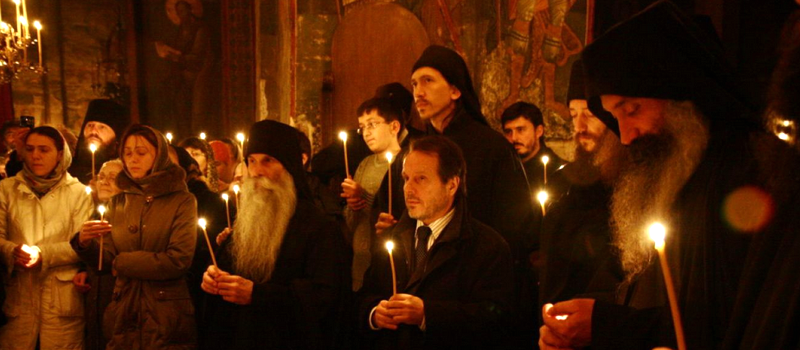
A couple of weeks ago I was having a conversation with an old friend about my spiritual journey. We had attended church together at a contemporary evangelical charismatic Protestant church as college students. At the time, I ardently defended contemporary worship. The songs stayed in my head for a great length of time, generally they reinforced the themes of what was being talked about in church, they were fun to listen to, and I could participate as a musician. I also appreciated things being relatively free-form. We stood at the start of services but it was generally accepted as a “starting position” from where you could sit, kneel, lie prostrate, lift your hands in the air, dance, etc as you wanted. Over time, I became very comfortable with an array of postures and utilized a full gamut regularly.
Therefore, the idea of going to a high liturgical church was a hard one for me. In my mind, everything in the liturgy equaled “script.” The minister said this, you said that. Stand, sit, kneel. Catholic aerobics done en masse. Moreover, it was the same. I once worked at a Lutheran summer camp when, in going to church on Sundays, my fellow staffers would ask the usher what service was being said. Some jargon like “Communion, setting 2″ would be exchanged and my friends would know exactly what to do. I didn’t get it.
Needless to say, I was surprised when I set foot into an Orthodox Church. I did not expect to find myself there at all. To make a long story short, I was without a church and approaching the Lenten season. Being without a church during Lent was unacceptable to me so a friend encouraged me to visit an Orthodox Church near me. That is a different story, so I’ll be sure to add it to my upcoming posts list.
At any rate, the Liturgy struck me because it was far from the picture I had of it. To begin, I was simply too overwhelmed by everything in the church. I lost my eyes to the icons, I lost my nose to the incense, I lost my ears to chanting… Once I stopped trying to take everything in at once, I got something. I literally had to close my eyes, turn on my brain, and focus to the words being said. Even trying to read a service book was a bit too disorientating because
a) there were a lot of things in the service book said at the same time as something else, and
b) my feet on the deep red carpet kind of gave me the impression that I was floating. Closing my eyes was easier. Wearing ear plugs to church didn’t seem like a wise move.
In focusing on what was being said, I found myself recognizing what was going on a bit more. The choir by and large sung arrangements from the Psalms. What wasn’t related to the Psalms was generally telling me about the Resurrection. There were some points where they told me stories about great Christian men and women in song. One woman in particular got a lot of attention: Mary the Theotokos. Yet it was clear to me that even in this odd presentation, the music presented a lot of the same benefits to me as it had previously in a “contemporary” church.
I grew bold so I opened my eyes. The reverence and solemnity of the people around, particularly on the part of the priests, struck me. People kissed things. A lot. But it wasn’t a procedural thing, people approached with gratitude and love. They did not compel me to do anything (except stand for the Gospel and the Great Entrance, but I wasn’t planning on sitting down anyway). The people at my parish let me decide in my own time how I wanted to participate. While it was overwhelming, I felt things align in my mind, heart and spirit.
In realizing that the Liturgy was far from a static structure and that it functions as a vehicle to ensure that the life of the Church is conveyed, I came to trust it. Over time, I’ve learned that my way of participating is not something that is entirely unique to me. Granted, there is a time and place for worship postures, but they generally flow with how I personally want to worship at that time.